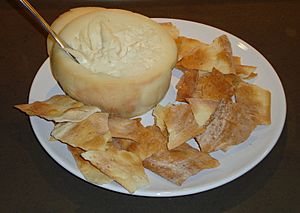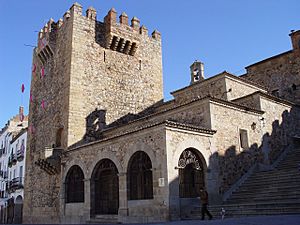Cáceres, Spain facts for kids
Quick facts for kids
Cáceres
Caçris (Extremaduran)
|
|||
|---|---|---|---|
|
|||
| Country | Spain | ||
| Autonomous community | Extremadura | ||
| Province | Cáceres | ||
| Judicial district | Cáceres | ||
| Area | |||
| • Total | 1,750.33 km2 (675.81 sq mi) | ||
| Elevation | 459 m (1,506 ft) | ||
| Population
(2018)
|
|||
| • Total | 96,068 | ||
| • Density | 54.8857/km2 (142.1532/sq mi) | ||
| Demonym(s) | Cacereños, -as | ||
| Time zone | UTC+1 (CET) | ||
| • Summer (DST) | UTC+2 (CEST) | ||
| Postal code |
10001-10005
|
||
Cáceres is a historic city in Spain. It is located in the Extremadura region. Cáceres is the capital and largest city of the province of Cáceres.
The city sits at the foot of the Sierra de la Mosca hills. It is part of the Vía de la Plata (Silver Route). This old path is part of the Camino de Santiago. It crosses western Iberian Peninsula from north to south.
Cáceres covers a huge area of about 1,750 square kilometers. This makes it the largest municipality in Spain. In 2014, about 96,000 people lived there. The old walled city is very special. UNESCO has named it a World Heritage Site.
Contents
History of Cáceres
People have lived near Cáceres for a very long time. We know this from ancient caves like Maltravieso and El Conejar. The Romans founded the city in 25 BC. They called it Castra Caecilia. It became an important city for them.
The Old Town (Parte Antigua) still has its ancient walls. This area is famous for its many storks' nests. Inside the walls, it looks like a medieval town. There are no signs of modern life. This is why many TV shows and films are shot there.
Cáceres was named a World Heritage City by UNESCO in 1986. This is because it shows a mix of different building styles. You can see Roman, Moorish, Northern Gothic, and Italian Renaissance architecture. There are still thirty towers from the Islamic period. The Torre del Bujaco is the most famous one.
The very first signs of humans in Cáceres are from about 25,000 BC. This was in the Late Paleolithic era. Paintings in the Cueva de Maltravieso (Cave of Maltravieso) show this. Some paintings are over 67,000 years old. Scientists believe Neanderthals made them. You can also see remains from Roman times, Moorish rule, and the Golden age of Jewish culture in Spain.
After the Roman Empire fell, the Visigoths took over. Then, the Arabs conquered Cáceres in the 8th century. The city was mostly under Arab rule for centuries. During this time, the Arabs rebuilt the city. They added walls, palaces, and towers like the Torre de Bujaco. Christians took back Cáceres in 1229.
During the 15th century, Cáceres had a large Jewish community. About 140 Jewish families lived there. In 1492, the Jewish people were asked to leave Spain. But you can still see signs of their presence in the Barrio San Antonio.
Cáceres grew a lot during the Reconquista and the Discovery of the Americas. Important Spanish families built homes and palaces there. Many people from Extremadura traveled to the Americas and became rich. In the 19th century, Cáceres became the capital of the province. This led to more growth. Today, the Universidad de Extremadura is located here. Also, several government offices are in Cáceres.
Climate
Cáceres has a Hot-summer Mediterranean climate. This means it has hot, dry summers and mild, wet winters. The average temperature in winter is around 8°C (46°F) at its lowest. In summer, the average high is about 34°C (93°F). Rain falls mostly in autumn and spring.
Historic Old Town
The "Monumental City of Cáceres" is very special. The Council of Europe called it the Third Monumental Complex of Europe in 1968. It was named a World Heritage site by Unesco in 1986. Cáceres has also won other awards for its beauty and history. It was even considered to be the European Capital of Culture in 2016.
Main Sights
Cáceres has many beautiful old buildings.
Churches and Convents
- Convento de San Pablo (15th century)
- Convento de Santa Clara
- Convento Jerónimas
- Convent de la Compañía de Jesus (Baroque style)
- Iglesia de Santa María (13th century, Gothic style cathedral)
- Iglesia de San Mateo (15th century, built on an old mosque site)
- Iglesia de San Francisco Javier (18th century, Baroque style)
- Iglesia de San Juan (13th to 15th century)
- Santuario de Nuestra Señora la Virgen de la Montaña
Palaces and Stately Homes
- Palacio de los Golfines de Arriba
- Palacio de los Golfines de Abajo: Queen Isabella I of Castile and King Fernando I once lived here.
- Palacio del Comendador de Alcuéscar
- Palacio-Fortaleza de los Torreorgaz: Now a hotel.
- Palacio de Carvajal (15th century): Now an office for tourism.
Education
The University of Extremadura was founded in 1973. It has a campus in Cáceres.
Transport
Cáceres is near the Autovía A-66 highway. This road connects Seville to Gijón. The Cáceres railway station serves many passengers each year. There is also a bus terminal with daily buses to other cities.
Festivals
- The Festival of the Martyrs (La Fiesta de los mártires) is in January.
- Carnival, The Festival of the Candles (La Fiesta de las Candelas), and Fiesta de San Blas are in February.
- The Easter Festival Semana Santa is held the week before Easter Sunday. Parades go through the narrow streets of the historic center.
- The San Jorge Festival is on April 22–23. A dragon is burned in a bonfire in the main square. There are also fireworks.
- The WOMAD music festival happens in early May.
- Ferias de San Fernando is held at the end of May.
Museums
- Cáceres Museum - ALJIBE: Located in the historical quarter.
- La Casa-Museo Árabe: Shows Arab culture, art, and history.
- Museo Concatedral de Cáceres: Displays religious art.
Nature and Outdoors
- Monfragüe National Park: This park is about 85 square kilometers. It has one of the largest areas of Mediterranean forest in Spain. It is home to over 1,400 different types of trees. It's great for birdwatchers. The park has the world's largest group of Black Vultures. You can also see the Spanish Imperial Eagle here.
- Los Barruecos Natural Monument: This area is about 14 kilometers from the city. It has huge granite rocks. It is the only place where White Storks nest on these rocks. There is also an old reservoir and a mill for washing wool.
Food and Shopping

The small streets in the historic center have many shops. They sell local products. Convents sell delicious homemade sweets and pastries. Wines from Extremadura are good and affordable. Local drinks include cherry liqueur from the Jerte valley. You can also find chestnut and blackberry liqueurs.
Other local products include sheep's cheese like Torta del Casar. There is also fig cake, chestnuts, and hams. You can find other pork products, lamb, olive oil, and paprika.
Cáceres is also known for its stews and roasted meats. These include pork, lamb, and game. Other popular dishes are fried breadcrumbs (migas), trout, pastries, and honey.
Sports
Cáceres has several sports teams. These include the association football team CP Cacereño. They play in the Tercera División. There are also professional basketball teams like Cáceres Basket. They play in the Liga LEB Oro. Club Baloncesto Al-Qazeres plays in the Liga Femenina. The Rugby Union Extremadura CAR Cáceres team plays in the DHB, which is the 2nd National division.
Twin Towns
Cáceres is twinned with these cities:
- Santiago de Compostela, Spain
- La Roche-sur-Yon, France
- Castelo Branco, Portugal
- Portalegre, Portugal
- Piano di Sorrento, Italy
- Netanya, Israel
- Lumbini, Nepal
Old Walls and Towers
- Torre de Bujaco (12th century)
- Arco de la Estrella (18th century)
- Torre de Sande (14th-15th centuries)
Notable People
- José de Carvajal y Lancáster (1698–1754), a statesman
- Juan Donoso Cortés (1809–1853), a diplomat and theologian
- Belén Fernández Casero (born 1974), a politician
- Carlos Floriano Corrales (born 1967), a politician
- Alberto Ginés López (born 2002), a professional rock climber
- María Guardiola (born 1978), a politician
- Marta Lozano Molano (born 1985), a composer and music scholar
- Elena Nevado (born 1967), a politician
- Cayetano Polo (born 1973), a politician
- María Telo (1915-2014), a jurist and feminist
- Gaspar de Zúñiga y Avellaneda (1507–1571), a Roman Catholic cardinal and bishop
Images for kids
See also
 In Spanish: Cáceres para niños
In Spanish: Cáceres para niños













